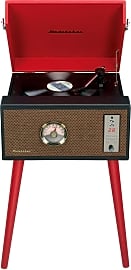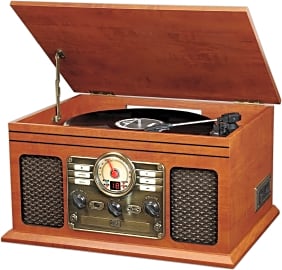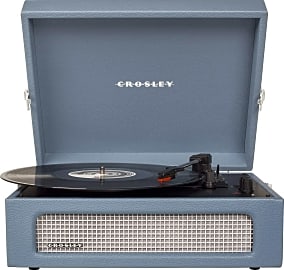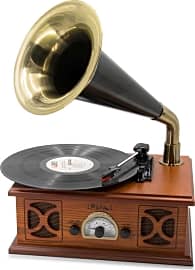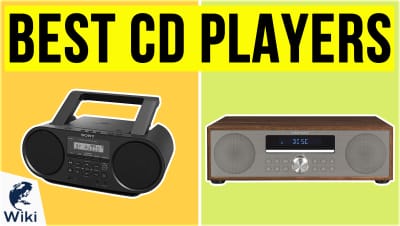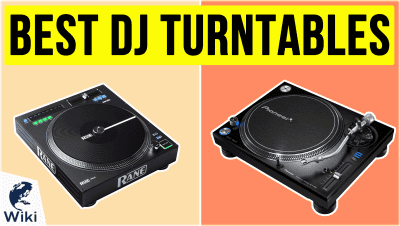The 10 Best Vintage Turntables

This wiki has been updated 39 times since it was first published in September of 2015. Now that vinyl records are making a widely-heralded comeback, you'll need to replace the stereo system you got rid of when you thought CDs or MP3s were going to be the final word in music storage. These vintage-style turntables combine the classic sound and aesthetics of a bygone era with some welcome modern features, like digital displays, remote controls, and Bluetooth connectivity. When users buy our independently chosen editorial picks, we may earn commissions to help fund the Wiki.
Editor's Notes
April 20, 2021:
While none of the items in this ranking are technically "vintage", this actually comes with some distinct advantages, such as the fact that they are more reliable than old players, parts are more readily available, and they can incorporate some useful modern features. For example, the LP&No.1 Retro functions like a traditional gramophone but has the advantage of a built-in MP3 player and a USB port for connecting drives. If it wasn't worth inclusion based on looks alone, then these modern touches - which also include Bluetooth connectivity - certainly earn it a place on this list.
We also included two attractively presented models that are inspired by the "dansette" record player-speaker combos of the 1950s and 1960s. The Crosley Sterling makes an attractive and functional addition to any living space and would sit equally well in a contemporary setting, as it would a retro environment, with its clean lines and pleasing contrasting color scheme.
Our final addition is the Studebaker Floor Stand, which is similar to the Crosley, but with a more eye-catching red exterior. This is notable for having a high-quality turntable with a counterweighted tonearm, an analog FM radio with a period-style large red dial, as well as a Bluetooth receiver, CD player, and an output of 3 watts RMS. Its removable legs aid portability, and when closed it forms a neat package with fasteners on either side.
It should be noted that many vintage turntables are novelty items intended for occasional use. Many do not feature counterweights on their tonearm, meaning too much pressure may be applied to the stylus, resulting in excessive wear on your vinyl over time, while others do not feature full-size platters, meaning that the records are more susceptible to knocks than those that do.
April 01, 2020:
It's important to remember that most of the vintage turntables on the market are vintage in style only; most are built today to modern stereo specifications with features like Bluetooth connectivity and even digital displays. Balancing out these modern conveniences with the style you're going for, especially when it comes to the display, is paramount. One of the coolest vintage style displays from our last list could be found on the Pyle 15UBT, with a dial that looked like it was ripped off the jukebox at a sock hop. Unfortunately, the player itself lacked durability and sound quality, and we felt like it needed to be replaced.
One of the newcomers to this list offers an aggressive reach into antique aesthetics, in the BandC White Classic Gramophone. Now, you're going to need a little bit of space to set this thing up, but it's undeniably a conversation starter, with a surprisingly high sound quality that results from a conversion of the primary speaker horn you'd see on old gramophones to serve solely as a tweeter. It gets 20 watts of stereo mids and a woofer built into the base. Personally, I think they made a mistake incorporating a digital display, but a well-cut piece of tape could hide it from most scrutinizing eyes.
And if you are in the market for a well-maintained and thoroughly inspected turntable that's actually vintage (and most collectors of electronics or clothing consider the term 'vintage' to apply to goods 25 years old or older), you can find a pair of such dealers in our special honors section.
Special Honors
Oak Tree Vintage Based out of Colorado Springs, this outfit of tinkerers has been fine tuning disregarded electronics for decades, and their expertise has come in handy for audiophiles looking to recreate the warm sounds of the vinyl they listened to growing up. Each model offers a lot of detail regarding the condition, repairs, and upgrades performed by the technicians, so you know exactly what you're getting. oaktreevintage.com
Vinyl Nirvana This website specializes in restored record players by Thorens and AR, with a wide selection of parts to service models by either company. Most offerings come with a cork rubber mat that serves as an aesthetic boost and as a practical way to protect spinning albums. The prices are a little high, but so is the quality of workmanship. vinylnirvana.com
Voice of Music 560 from The Vintedge Co. Fans of vintage stereo equipment are bound to appreciate the craftsmanship that goes into the Voice of Music 560. These reproduction record players not only look the part but also feature Bluetooth connectivity and old-school record changer technology. Records can be stacked for continuous play, and they produce sound to match their looks, with a distinctively warm tube tone. thevintedgeco.com
ATX Custom Record Players This quirky company made the switch from hot-rodding cars to creating these record players with built-in speaker cabinets and you'll be glad they did, should you ever get your hands on one. They feature retrofitted turntables that combine vintage looks with modern reliability and provide an all-in-one solution for storing drinks, albums, glassware, and electronics in beautifully crafted and functional units. atxrecordplayers.com
Still Turning: The Timeless Turntable
Simply put, when most people choose a turntable, they choose an item they want to show off.
Recent history confirms the old idiom that, given enough time, "everything old is new again." Take for example the resurgence of print book sales over the past several years, which had previously faced a decline and even some assumed extinction after the birth of the e-book.
Another ostensibly atavistic device that has enjoyed a recent return to popularity is the vintage turntable. Also simply called a record players, turntables graced the living spaces of millions of homes throughout many decades of the 1900s. Records were largely supplanted by audio cassette tapes in the 1970s, which were in turn surpassed by compact discs in the later years of the 20th century. CDs saw their crown taken by digital music (usually in the format of the MP3) around the recent turn of the century. While cassette tapes and compact discs are unlikely to make a dramatic comeback to popularity, the record and its accompanying turntable certainly have.
There are several reasons for this, but the inherent attractiveness of a turntable — and even of a record itself — cannot be denied. While cassettes and CDs could be played by devices small enough to fit in a purse (and while digital music can be played using a device that tucks into a change pocket), turntables are by their very nature larger devices, as they must accommodate broad, flat records. Most turntables — modern units made to resemble vintage options included — are designed with aesthetics in mind, approximating the look of a piece of decor while serving as a functional device.
Simply put, when most people choose a turntable, they choose an item they want to show off. We perch our record players prominently in our homes, proud to have them seen and heard. Fortunately, advances in technology have allowed many modern turntables to be relatively compact without sacrificing the elegant stylings for which record players have always been prized.
When choosing a record player, you should first see it as a device to play music, of course. Consider the sonic features you want, such as a built-in radio, the ability to output to external speakers, the ability to accept inputs from a computer or digital music device, and the control features (knobs and switches or an LCD screen and buttons, e.g.). Once you have established a checklist of features you want your vintage-style turntable to possess, consider the space in which it will sit in the home (and whether or not portability is a factor), as that will help further refine your search. Finally, simply choose the unit that suits your technical and size considerations while still looking great.
How Carved Discs Make Sweet Sounds
The same principles at work in a "modern" turntable have been understood for more than 150 years, yet many audiophiles still insist that the record is the best way to enjoy music. As for how a record player works, it is all a matter of controlled vibration.
The minute motions of the stylus are transferred to a magnet that is wrapped in coiled wiring.
Sound is imprinted on a record using a specialized cutting machine that carves minute formations — essentially divots, bumps, and valleys — into a master plate as it revolves. These formations are created in response the frequencies, or sound waves that are projected into and through the cutting machine during the recording process. Those plates are then used to print records.
When a record is placed on a turntable, the process will be effectively reversed in order to create sound. As the record spins, the needle set into the stylus and bearing down on the disc rises and falls as it encounters the formations carved into the surface (they are far too small to be appreciated with the naked eye). The minute motions of the stylus are transferred to a magnet that is wrapped in coiled wiring. When this wiring experiences the proper electrical current, it transfers the vibrations to an attached (or linked) amplifier, which then projects the electrical energy in vibrations we hear once again as sound waves.
Stereophonic sound — when sound is produced from one device along at least two distinct audio channels, these being Left and Right in their simplest form — is created by a record player when the needle encounters formations that maneuver it both up and down and from side to side. While records can produce rich stereo music, by the nature of their design, they cannot produce any more channels of audio, thus presenting at least one aspect in which digital music recording does surpass older technology.
The History of the Turntable
The first noted mention of technology approximating that found in a turntable came in 1852. In that year, the word phonograph appeared in a New York Times advertisement, though it was in reference to a course related to the study of sonic technology, not referring to an actual device.
Simple devices that could record the vibrations made by sounds were developed in the later 1850s, but they did not offer the ability to play back the sounds responsible for the logged patterns.
The first noted mention of technology approximating that found in a turntable came in 1852.
The word phonograph, which is derivative of two Greek terms, phono and graph, which together essentially mean "sound writing," would first be applied to an actual device in the year 1877. In that year, Thomas Edison revealed the first working device that could both record and play back sounds. The phonograph used a cylinder wrapped in tinfoil as the medium for recording sound, and the resulting recordings were rather unclear and easily damaged or destroyed.
Primitive as the early hand-cranked phonographs look in comparison to modern options, the same basics of the technology that carved grooves into a little cylinder would come to be used in record players popular throughout the 1900s and into the present. The first flat, disc-shaped records were introduced in the late 1880s, but would not dominate the audio marketplace until another two decades had passed.
By the mid-1920s, the cylinder was finally fully surpassed by the disc-shaped record once and for all; from then on, the record player would be refined and enhanced, but would retain its essential shape and function.


